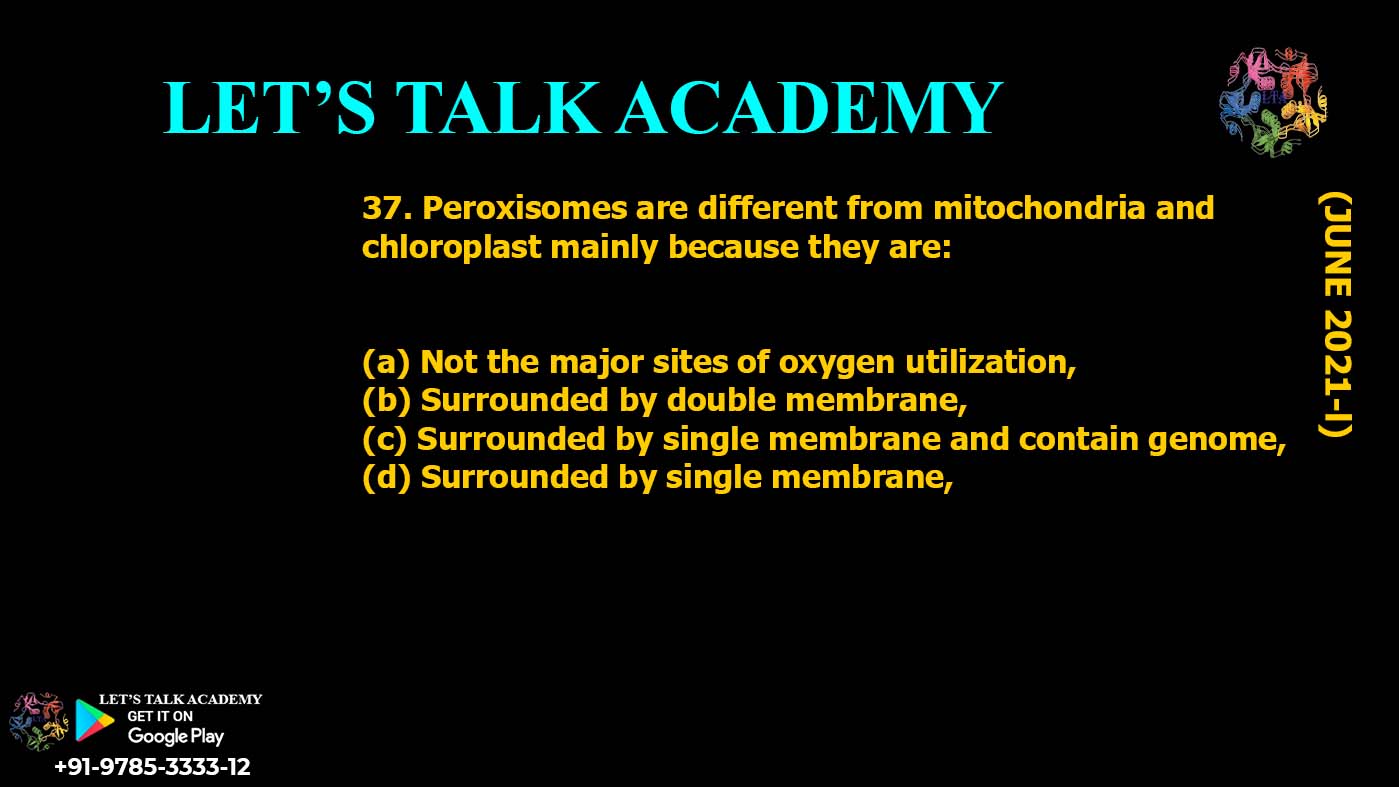37. Peroxisomes are different from mitochondria and chloroplast mainly because they are:
(a) Not the major sites of oxygen utilization,
(b) Surrounded by double membrane,
(c) Surrounded by single membrane and contain genome,
(d) Surrounded by single membrane
Introduction
Peroxisomes, mitochondria, and chloroplasts are three important organelles found in eukaryotic cells, each serving vital functions in cellular processes. While these organelles share similarities, particularly in their involvement in energy metabolism, they also have significant differences in terms of structure and function. One of the most notable differences is the way they are enclosed by membranes.
In this article, we’ll focus on the unique characteristics of peroxisomes and compare them with mitochondria and chloroplasts to understand their distinct roles in cellular processes.
What Are Peroxisomes?
Peroxisomes are small, membrane-bound organelles found in the cytoplasm of eukaryotic cells. They play an essential role in the breakdown of fatty acids, detoxifying harmful substances, and aiding in the metabolism of hydrogen peroxide. Unlike mitochondria and chloroplasts, peroxisomes have a single membrane and lack the internal structures (like inner membranes or thylakoids) seen in mitochondria and chloroplasts.
Key Characteristics of Peroxisomes
-
Membrane Structure: Peroxisomes are surrounded by a single membrane, which is one of their defining features when compared to mitochondria and chloroplasts. Mitochondria and chloroplasts, on the other hand, are double-membraned organelles, with an inner and outer membrane.
-
No Internal Genome: Unlike mitochondria and chloroplasts, which contain their own genome (DNA) and can produce some of their own proteins, peroxisomes do not have a genome. Instead, peroxisomes rely on proteins encoded by nuclear DNA for their function.
-
Oxygen Utilization: Peroxisomes are not the major sites of oxygen utilization in the cell. While mitochondria are the powerhouse of the cell, generating energy through aerobic respiration, peroxisomes mainly handle oxidative reactions that break down fatty acids and detoxify harmful molecules.
Comparing Peroxisomes with Mitochondria and Chloroplasts
-
Mitochondria: Known as the cell’s powerhouse, mitochondria are double-membraned organelles that generate energy through aerobic respiration. They also contain their own DNA and ribosomes, allowing them to synthesize some of their own proteins.
-
Chloroplasts: Found in plant cells, chloroplasts are also double-membraned organelles that conduct photosynthesis to convert light energy into chemical energy. Like mitochondria, they contain their own DNA and are essential for energy production in plant cells.
-
Peroxisomes: Unlike mitochondria and chloroplasts, peroxisomes are primarily involved in metabolic processes such as fatty acid oxidation and detoxification of hydrogen peroxide. They are surrounded by a single membrane and do not contain their own genetic material.
Answer:
The correct answer is:
(d) Surrounded by a single membrane.
Conclusion
Peroxisomes are crucial organelles in eukaryotic cells that differ from mitochondria and chloroplasts in their membrane structure, functions, and genetic content. While mitochondria and chloroplasts have double membranes and contain their own genome, peroxisomes have a single membrane and rely on nuclear DNA for their functions. Understanding these differences helps clarify the unique roles each organelle plays in maintaining cellular health and function.




3 Comments
Akshay mahawar
April 23, 2025Done 👍
Pallavi gautam
April 23, 2025Yes sir👍✅
yogesh sharma
May 8, 2025Done sir